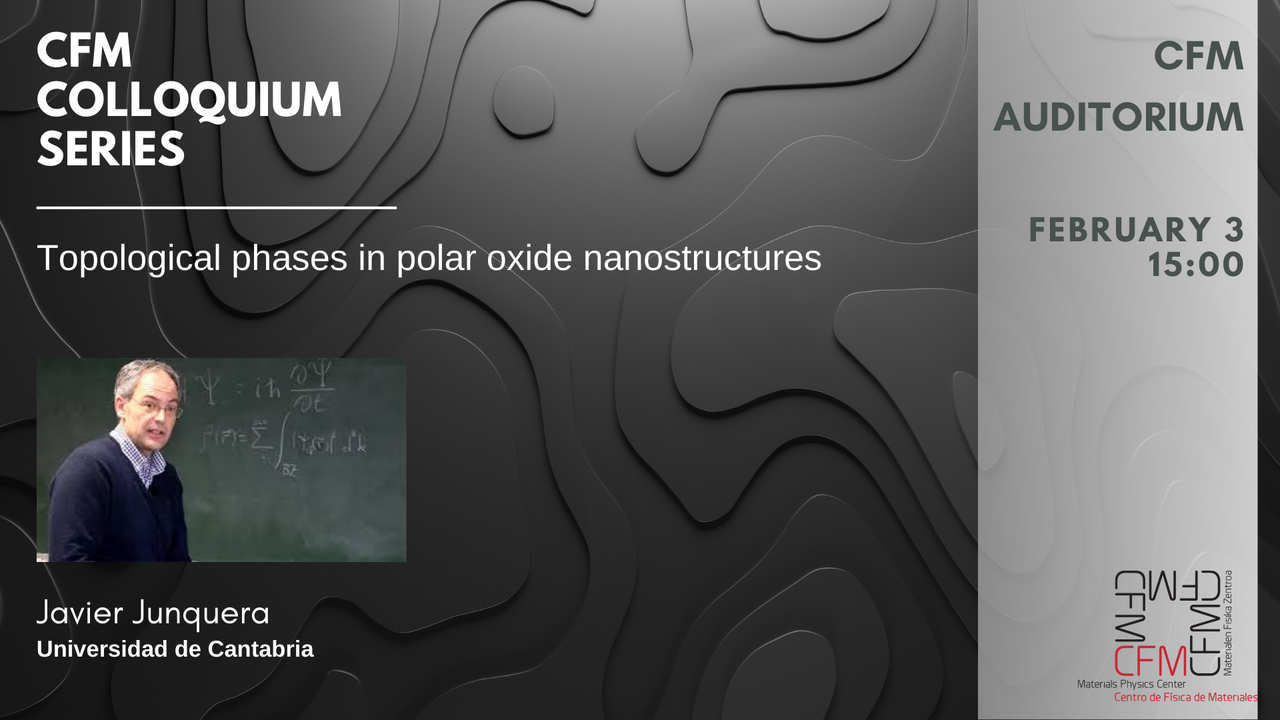Topological phases in polar oxide nanostructures
CFM Seminars
- Speaker
-
Javier Junquera
Facultad de Ciencias Universidad de Cantabria - When
-
2025/02/03
15:00 - Place
- CFM Auditorium
- Host
- Ivo Souza
- Add to calendar
-
iCal

CFM Colloquium Series
Complex topological configurations are a fertile area to explore novel emergent phenomena and exotic phases in Condensed-Matter Physics [1]. The discovery of magnetic skyrmions one decade ago [2] have triggered a flurry of research on these particle-like nanometer-sized topologically protected spin textures, mostly motivated by their potential use in spintronic devices such as race track memories [3]. Since then, researchers have long wondered whether ferroelectrics may present topological textures akin to magnetic skyrmions and chiral bubbles. In this quest, the side by side advances in experimental growth and characterization techniques, and the development of new modelling tools are of paramount importance. In this respect, the emerging field of second-principles simulations [4-5], where an effective model is constructed by a judicious choice of the essential physics, and the parameters of the model are extracted by fitting to Density Functional Theory, are proving increasingly valuable in the study of large systems, overlapping in size with those that can be currently grown by atomic layer deposition methods. As a result of this continuous feedback between theory and experiment, the recent discovery of polarization vortices [6] and their associated complex-phase coexistence and response under applied fields in superlattices of (PbTiO3)n/(SrTiO3)n [7] suggests the presence of a complex, multi-dimensional system capable of emergent physical responses, such as a switchable chirality [8,9]. In this talk, I shall describe the latest developments to create, tune, and characterize topological textures in ferroelectrics [10,11]. Polar structures with a well-defined topological charge and chirality will be presented. The stabilization of such non-uniform polarization topology results in highly enhanced susceptibilities, and also provides a pathway for engineering novel functionalities previously inaccessible, such as regions with negative capacitance [12,13].
Financial support from Grant No. PID2022-139776NB-C63 funded by MCIN/AEI/10.13039/501100011033 and by ERDF “A way of making Europe” by the European Union.
References
[1] J. Junquera et al., Review of Modern Physics 95, 025001 (2023)
[2] N. Nagaosa and Y. Tokura, Nature Nanotechnology 8, 899-911 (2013), and references therein.
[3] S.S. Parkin, M. Hayashi, and L. Thomas, Science 320, 190-194 (2008)
[4] J. Wojdel et al., J. Phys.: Condens. Matter 25, 305401 (2013)
[5] P. García-Fernández et al., Physical Review B 93, 195137 (2016)
[6] A.K. Yadav et al., Nature 530, 198-201 (2016)
[7] A.R. Damodaran et al., Nature Materials 16, 1003-1009 (2017)
[8] P. Shafer et al., Proceedings of the National Academy of Sciences of the United States of America 115, 915-920 (2018)
[9] P. Behera et al., Science Advances 8, eabj8030 (2022)
[10] M. A. Pereira Gonçalves et al., Science Advances 5, eaau7023 (2019)
[11] S. Das et al., Nature 568, 368-372 (2019)
[12] A.K. Yadav et al., Nature 565, 468-471 (2019)
[13] S. Das et al., Nature Materials 20, 194-201 (2021)
